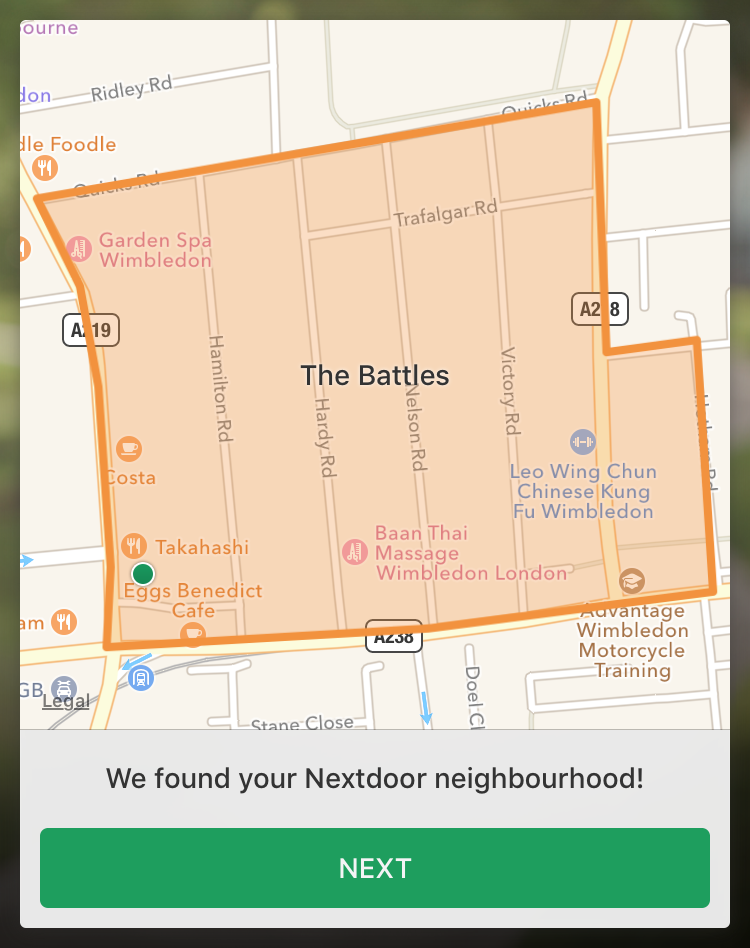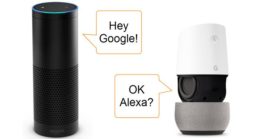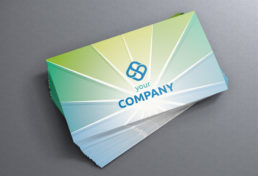Shhh! The walls have ears.
2017 is shaping up to be the year of the digital assistant.
Devices featuring voice recognition digital assistants took CES by storm this year. Intelligent, voice activated digital assistants abound. Amazon has Alexa, Microsoft has Cortana, Apple has Siri and Google has… well, Google.
Amazon’s Alexa stole the show as it seems to have gained first mover advantage by not only featuring successfully in the popular Amazon Echo device, but also being the voice recognition system of choice for other companies producing everything from media streaming to fridges.
I think people are just waking up to the possibilities for – and dangers of – this technology.
We were amused by the story of a 6 year old girl using Alexa in her parent’s Amazon Echo to order herself a dolls house. When the news was reported on local TV in San Diego, the words spoken by the newscaster triggered other Amazon Echoes within earshot of tuned-in TVs to perk up and attempt to do the same. Ooops.
The trouble is – that’s how easy it can be to voice activate these digital assistants. They hear their trigger phrase (or think they hear it) and off they go. I’ve often seen my Google phone activate when it thinks it hears me talking about the Google Assistant (normally using the words, “OK Google” as part of a wider conversation on the topic).
"People are just waking up to the possibilities for – and dangers of – this technology."
Should we be concerned about this?
Maybe. You may or may not know that Google already records and retains all your Google activity. This includes keeping an audio transcript of everything you say whenever you activate Google’s digital assistant. Alexa does the same thing. You can review and delete these messages, but they are there.
You can see your Google audio transcripts by visiting https://myactivity.google.com and filtering the content to “Voice & Audio”.
When we tried this, we found that many snippets of conversations had been captured and could be replayed at the touch of a button. This included personal or work related conversations that could have included sensitive material. Try it yourself, it’s a little unnerving.
We’re not discussing anything nefarious here – but why does this make me uneasy? The thing is, these tech firms say they need to capture and retain this content to help fine tune the accuracy of their digital assistants. Maybe…but still.
On that note, whilst Alexa is the star of this year’s CES event, newly arriving Google Home (not yet available in the UK) may yet win the race. The search giant may be a late comer to the personal assistant device party but it’s own Google Assistant should, on paper, have access to a wider range of information than Amazon.
If only it had a more personal name than “Google”. My bet is that it will sooner than we think.
Digital businesses boom in London
London is open.
Facebook, Google and Apple have announced major expansions in London, proving the capital is open to the world’s biggest brands and is the leading city for trade and investment.
Facebook announced they will be doubling their presence in the UK by opening new headquarters in London’s Fitzrovia. The new hub will open in 2017, creating 500 additional jobs including engineers, marketers, project managers and sales staff.
Google, who already has a London HQ, is moving 2,500 staff into brand new digs in King’s Cross. The new 371,000 sq ft building consists of 11 floors and even includes a 90m running track for employees to let off some steam. Rumour has it the tech giant has snapped up a number of nearby properties, suggesting further developments in the future.
Rumour has it Google has snapped up nearby properties for future developments.
Earlier in the year Apple revealed that they will be making Battersea Power Station their new headquarters, spending an eye-watering £9 billion on the project. Apple will be moving 1,400 staff from multiple sites around the capital into their new campus, expected to be open in 2021. Apple will occupy six floors (500,000 sq ft) of the Grade II listed former electricity generator.
London’s position as a global technology hub isn’t showing any signs of slowing down anytime soon.
Up your game with these 9 Instagram hacks
It's tough in the world of Instagram.
With over 500 million active monthly users, it can be difficult to find and interact with your ideal audience. Are you struggling to create content that people like, or failing to gain engagement and followers? Get the most out of Instagram with these nine hacks.
1. Hashtags
Did you know the most popular Instagram hashtag is #love? A sure-fire way of getting more likes, followers and comments is by using hashtags. Use appropriate (repeat: appropriate) hashtags on your posts and you’ll find your engagement rates sky rocket. You’re allowed to use up to 30 tags per post, excluding comments, which means you can comment on your own photos with extra hashtags to reach more people. Do some research about what your competitors are tagging and, if you can think of a use for it, create your own hashtag.
2. Lighting
Instagram is all about photos, and good photos need great lighting. A well-lit, naturally bright photo will always get more likes than a dark photo. It’s a no-brainer. Try to take your photos in a light room (or outdoors), but stay away from harsh sunlight.
3. Angle
Know your flat lays to your FWIS’s. Products, food, clothes and more can benefit from flat lays. Essentially this is taking a birds-eye view photo of your subject laid flat on a surface. Check out @flatlays Instagram account for inspiration. FWIS (From Where I Stand) is another popular Instagram angle, which creates a sense of viewing life through someone else’s eyes. Just make sure you have cool shoes on. Check out @fromwhereistand.
4. Filter
Instagram’s own filters are sufficient for some, but not us. We love Ludwig, Juno and Crema, but sometimes it’s just not enough. Use your phone’s inbuilt photo editing software or our favourite app, VSCO, for more editing options. VSCO has hundreds of free filters to choose from and, better yet, you can upload a VSCO edited image to Instagram and continue to edit in-app. Your editing options are endless, just don’t go OTT. Once you’ve found your favourite filter style, try to stick to it.
Know your flat lays to your FWIS’s.
5. Captions
Keep them short, sweet, informative. Think of it this way: if you’re posting a photo of your dinner, we already know quite a lot about your meal. You might want to tell us what it is, if it was nice, or how to make it. Instagram users scroll through photos quickly, so you don’t have much time to grab their attention. Chuck in an emoji if you’re feeling fancy.
6. Timing
When’s the best time to post on Instagram? Good question. Start with your audience demographic. How old are they? If they’re of working age, posting during working hours should be avoided. Where do they live? Don’t forget about time differences. If your audience is in the UK and USA, posting in the evening (UK time) is a good place to start. When is your audience online? At school, whilst commuting, whilst the kids are at school, in the evening, etc. Think about your audience, combine these answers and you’ll find your perfect time to post on Instagram.
7. Links
Instagram does not like links. No one will copy a link and paste it into their phone’s browser, so don’t bother pasting a link into the caption of your photo. The only way around this is by changing the clickable link in your Instagram bio. If you’re releasing a new product, plugging a blog post, or referring to a recipe, pop the link in the URL section of your bio. Change this link before you post or immediately afterwards – IGers are fast movers.
8. Take advantage of Instagram’s apps
Instagram is not a one-app band. In fact there are three official sub-Instagram apps to enhance your Instagram experience. Boomerang adds fun to your stream by creating short, snappy videos that play on a loop (a bit like Vine, but shorter). Layout answers all your photo mosaic prayers, giving users a number of – you guessed it – layouts to input multiple photos. Hyperlapse creates stabilised time lapse videos that allows you to edit the speed of the video.
9. Engagement
Believe it or not, Instagram isn’t just about cool photos. There are real people behind Instagram accounts, and they like to talk. If someone comments on your post, don’t ignore it. Respond to get the conversation flowing. In the same breath, spend time commenting on other people’s posts, too. You’ll find that this helps to get you noticed as an active and engaging user, which is exactly the kind of user people want to follow. Ka-ching.
That’s it. Whilst nothing happens overnight, if you abide by these nine hacks, you’ll no doubt propel yourself (or your company) through the harsh digital world that is Instagram. Good luck!
Business cards, do we still need them?
A resounding Yes!
OK, we live in a digital networking age where everyone can be found online somewhere – a corporate website, a social media channel, a PR piece, Blog post, whatever. But no matter how digitally advanced we are your business card often remains a potential customer’s first contact with you and your company.
The old saying still stands: you never get a second chance to make a first impression. A business card connects with a new prospect on a personal level, encourages them to find out more about you and what you do. A well-designed, simple, impactful business card does this. Here are some of our most practical tips on creating a distinctive and professional card.
1. Logo and tagline
You may think it’s a ‘no-brainer’ but I can’t tell you how many business cards we’ve come across with either no logo at all or, possibly even worse, a really ill-conceived or blurry or smudgy logo.
And what, precisely, is the purpose of knowing your company is XYZ Solutions if you don’t let me know what solutions you could bring me? Think about a four- to five-word company descriptor, that is clear and precise, and hey presto, you’ve got your tagline.
Your logo and tagline are extensions of your brand, and your business card needs to convey your business to your audience in a powerful and memorable way. Your prospects should be able to identify your brand and instantly recognize it wherever they see it in the future – on your website, your portfolio, your email signature, or your premises.
2. Name and job title
Seems obvious, doesn’t it? It’s likely that business cards have the contact’s name on it. But if they do have a job title, then that doesn’t necessarily tell you what role they perform in the organisation.
Let’s start with the name. My name is Andrew, and it’s always Andrew. It’s never Andy. So many times I’ve been given a card from an Andrew / Katherine / Stephen and I’m immediately told that they go by the name Andy / Kate / Steve. If that’s the case, and you want to make a personal connection with the prospective new customer then put the name you want to be known by on the card. But let’s just stick to real names and avoid at all costs nicknames or buddy names.
When I see a job title on a card I want to know what that person actually does. Quite how much help is it (besides finding out how high they sit in the company’s organogram) to find out this person is a Managing Director or Partner or Director? By the time I’m back at the office I’m not sure what the person’s job was or why I should call them. So, Jane Jones, Partner, ABC Financial doesn’t tell me much. But Jane Jones, Corporate tax expert and Partner, ABC Financial does.
3. Contact Information
OK, we’ve come this far. You’ve met someone interesting. You’ve impressed them with your brand, and it’s clear to them what you do and how you can help them. As they are passed from hand to hand, business cards create a personal connection between you and your contact. Now you need them to get in touch following this meeting.
The contact information is the substance of the business card. You need to make it as easy as possible for people to contact you. But which of all your contact details should you include? The key here is that you want this person to contact YOU. You want to make it easy for them. So it would be counter-productive to send them through a labyrinth of gatekeepers and digital dead-ends. Let them have your direct contact details.
Email addresses such as info@ or office@ are generic and impersonal and frustrating, as are switchboard telephone numbers or voicemail hell.
Lots of business cards these days don’t include a physical address on their business cards. Leave this out if you’re struggling for space. But include it if your business model is local, or related to a geographical area. Often, prospective customers may specifically want to do business with a local firm.
Make sure the card doesn’t look cluttered – space is good! Don’t be tempted to overstuff it with detail as this will not have a positive impact.
A good business card is an extension of your brand, and needs to be memorable and impactful, appealing to all the senses.
4. Social media profiles
You should always include your social media profiles on your business card, as they have now become indispensable if you want to connect and engage with your target market. But you don’t have to use all of them. Your social media profile is important as, with a lot of your potential target audience, if you’re not on social media then you don’t have a public profile.
But don’t overwhelm your audience. Remember what we said above about being clear and easy, and that space is good? You don’t need to list all your social media accounts on your business card. Think strategically about your accounts and only list the few channels where contacts can get an overall impression of your business and the ones you’re most active in.
If your business has several social media accounts then a good tip is to ensure that all the handles on your multiple channels are the same, for example @abcfinancial You could then simply display on your card: social @abcfinancial People these days are knowledgeable enough to know to search the various channels using your handle.
5. Use the back of the card
Always use the back of the business card! This is free advertising space. You’ve managed to get your card in you contact’s hand and one of the first things they’ll do is flip it over. I always do, but maybe that’s because I’m a marketer.
This space is free space to highlight your branding or messaging. Whatever you do, use it wisely and make it memorable. You can use your logo and brand, photos, brand statements, a short company descriptor – anything memorable.
6. Production values
Without naming names, we recently designed a fabulous business card for one of our clients which ticked all the boxes above. When it came to printing the cards, some bright spark within the operation thought they would earn brownie points with the boss by sourcing a much cheaper print quote than we supplied. And the boss went with this cheaper quote. Although the business cards were beautifully and effectively designed, when printed they looked exactly what they were – cheap and nasty and, frankly, an embarrassment to the company.
You’ve come all this way, so don’t fall at the last hurdle. Once your design and content are spot on, push the boat out and produce quality cards that have the required, positive impact with your new contact. Engaging more than one sense at a time – in this case, touch and feel – improves recall, so people will be more likely to remember your business, in a positive way, if you have high production values.
Thicker cards feel more expensive and they make your business seem more professional. You should also consider having a good finish, something like a matt or gloss laminate. There are a wide range of finishes available, so speak to your printer (or a good agency) and do the right thing.
A parting word: A good business card is an extension of your brand, and needs to be memorable and impactful, appealing to all the senses. It should convey, clearly and concisely, the right information about who you are, what you do, and the easiest ways possible of contacting you.
Facebook launches Workplace
Workplace by Facebook is a new way to communicate with your colleagues.
When was the last time you communicated with your friends by email? Ages ago, we bet. Facebook Messenger, WhatsApp, iMessage and FaceTime provide us with a simple way to talk and share images and videos with our friends and family. Workplace by Facebook combines all of these features but is designed for communicating with our colleagues. Instead of using Facebook before and after work, Facebook wants us to use the platform during working hours too.
Here’s how it works: Workplace by Facebook has the same look, feel and features as Facebook. Colleagues can create groups (e.g. “Advertising” or “A/W 2016 Ideas”), invite other colleagues and use the platform to brainstorm, share photos, arrange and hold meetings online, and much more. Think of it as a Facebook page just for your office.
Importantly, and quite rightly so, your personal Facebook and Workplace Facebook pages are completely separate. No more worrying that your latest drunken escapade will be on show to your bosses.
Workplace could replace all emails within your company.
Admittedly, similar services have been around for years. The difference is everyone is familiar with Facebook, making Workplace much easier to navigate and for newbies to hop on the bandwagon seamlessly. It involves very little training, meaning fewer costs for businesses.
We now have an excuse to spend all day on Facebook.
What about security? You’re probably hesitant to discuss business critical, highly sensitive information on a social network, right? The good news is that Facebook is serious about security. Companies control all of their data, meaning you can modify, delete or export your data at any time. You can read more about Workplace by Facebook’s security here.
We expect companies with a large workforce will benefit the most from Workplace. It seems like a great place to collectively brainstorm and communicate, which can be tricky and confusing when you have to factor in 50 members of a team via email.
If you’re still a bit confused about how Workplace by Facebook works, watch this video.
Top 5 website questions we get asked
How much does a website cost? How quickly can a website be built? These are the top 5 website questions we get asked, answered.
1. How much does a website cost?
How long is a piece of string? Our websites are all bespoke. We don’t have packages because every client has different needs. Think of it in terms of buying a car: do you want a run-around to get you from A to B, or do you want a convertible with all the bells and whistles? Sorry to say, this isn’t a one size fits all answer. We have built websites in the region of £2,500 all the way up to £35,000+
2. How long does a website take to build?
Believe it or not, this heavily depends on the client. We have built a website in 48 hours. That said, it can take a lot longer. On average, it takes about 6 weeks, but if you’ve got your copy, content, images and a clear idea of what exactly you want on your website, the process will be a lot smoother. If you don’t have any copy, if you change your mind about the look and feel of the site, or any other odd factors pop up, well… It will take a lot longer. Click here to read the 6 things to consider before creating your website.
3. Can I manage my website myself?
Yes. We specialise in WordPress websites, which is a popular CMS (Content Management System) that gives you, the client, full access to your website. We will train you to use the system before or after launch (you decide) or if you don’t have the time to manage the website yourself, we can do it for you. We’re always on hand to help if you need advice. This freedom allows you to change copy and images and even create pages yourself.
4. How can I stop my website being hacked?
Good question. This is where hosting comes in. Websites don’t simply live on the internet; they have to have a place to sit, or a home, which is what hosting provides. We use a reputable, reliable and extra secure WordPress host called WP Engine, who identifies and prevents attacks before they happen, meaning your website is completely safe in their hands. Think of it like this: your website is your supercar, and hosting is your safe and sound garage, including your burglar alarm, security gates, CCTV and guard dogs all in one. No one’s getting past WP Engine. You don’t have to use our hosting provider, but it’s definitely recommended.
5. Will my website work on a mobile?
Yes. The great thing about WordPress is that all the websites we build are mobile-friendly. This means that you don’t need to create a separate mobile website. Instead, your website will automatically reconfigure itself to fit a mobile without losing its style. Even better, this is the case for any device; tablets, laptops, and mobiles are all covered. Google favours mobile-friendly websites, so your website is more likely to be found by your potential customers.
How to create an Instagram business profile
Finally, Instagram business accounts have arrived.
The change adds a call-to-action button to your page, displays your sector, and, most importantly, has analytics.
Making the change is simple.
- On your mobile, open Instagram
- Go to the profile you want to change to a business account
- Click on Settings (top right corner)
- Scroll down and click "Switch to Business Account"
- This will prompt you to login to Facebook
- Login to Facebook and allow the app to view your Pages
- Select the page you want linked to the Instagram account
- Confirm the details of your business
Done! Your page will now be a business account.
PLEASE NOTE: Be cautious when choosing an account to make a business account - you can only authorise ONE page on Facebook to be an Instagram business account. This means if you manage more than one Instagram account, only one will be able to be a business account.
Once you've made the change, your page will change slightly. There will be a call-to-action Contact button under your general stats, and you'll be able to explore analytics in the top right-hand corner or on individual posts.
Get snapping!
Nextdoor: Connect with your neighbours
Originally tested in the US, new social media network Nextdoor, aimed at encouraging social interaction between your neighbours, is launching in the UK.
Nextdoor enables you to interact with your neighbours via a mobile app. Neighbours can post about crime alerts, items for sale, required services (babysitter, plumber, etc), parking or building notifications, events, and much more.
Lost your pet? Found a child's toy? Maybe there's an issue with litter on your street? You can discuss this directly with your neighbours on Nextdoor.
Neighbours must verify their address via postcard or phone number, and once verified (and there are more than 10 members in one neighbourhood), the fun begins. The app has proved a great success in the US and has been tested in 500 neighbourhoods in the UK. It is thought that the timely launch of this app will help to rebuild local communities as a result of the Brexit vote.
We have social networks for close friends and family, for places we want to visit, for following celebrities, and for contacting businesses. Why not create a social network for our neighbours? Nextdoor is the ultimate community noticeboard.
The app is new to the UK so you might find that your neighbourhood doesn't have enough members to get started. So tell your family and neighbours that you (might) already talk to about the app to get the ball rolling.
More here: https://nextdoor.com/
We've signed up and below is an example of our neighbourhood.

Twitter to relax 140-character limit
Good news coming from Twitter's towers today.
Have you ever sent a tweet with an image, video or GIF and been frustrated that it takes up a chunk of your 140 character limit?
It seems like a lot of users are fed up of the restriction as Twitter announced that it will no longer count photos, videos, GIFs and links from its 140 character limit. The change will give users greater freedom to compose longer messages.
Whilst the news was announced way back in April 2016, the feature is coming into effect very soon, we're told.
Here's what will no longer eat up your character limit:
- @names when replying to a tweet
- Media attachments - photos, GIFs, videos, polls, quote tweets
Another major change is that Twitter will show your "@name" tweets to all followers. Currently, when beginning a tweet with an @name, only the person mentioned will see the tweet in their stream. The workaround for this was for users to use ".@name", which would show the tweet to all followers. Don't worry, if the person mentioned replies, this won't show up on your timeline.
Twitter is staying tight-lipped on the official launch date of these updates, but our guess is that it's sooner rather than later. Watch out for the changes over the next two weeks or so.
UPDATE: The changes are live! They came into effect on the evening of Monday 20th September 2016. Happy longer tweeting.
10 Social Media Sins
Resident web development manager, Adam Leone (and self confessed social media grump) is having a bit of a moan and has come up with ten social media sins. These are just some of the things we experience on a daily basis on Facebook, Twitter and Instagram.
1. Referring to loved ones as "This one" or "These people"
Posting a picture of your friend or loved one, with a description that reads along the lines of "Found this one at the pub".
Ah, yes - only the true 10 or so friends will get what you're talking about. Good job you were so cryptic about your relationship with "this one".
2. Motivational posters, quotes and memes
An image of a sunset, someone walking down an empty road or someone looking longingly into the distance with a quote or caption by someone that we've never heard of.
We all have that one friend on Facebook who feels the need to preach through the use of memes or posters about how we can best live our lives.
3. Detailing your child's every move
It's become a trend now to upload images of ultrasound scans, followed by an image of the little one fresh out of the womb.
Here's something to consider before you next post a picture of your little one. No one cares about your child as much as you do.
4. Adding the word "Life" to hashtags
Uploading pictures of yourself on a beach, on a boat or somewhere else, accompanied with hashtags ending in "life". #YaughtLife #BeachLife #AnnoyedLife.
We get it, your existence on this earth is perfect because you've nestled yourself into whatever niche or fad that best suits your #QuirkyLife.
5. Uploading too many holiday photos
This is a fairly obvious one. Twenty photos is enough - not a 100.
Why is this annoying? Facebook is a place to pick and choose what you want people to see, not every little thing that goes on during your trip away - nobody is really that interested in you. Also, holiday photos just advertise the fact that your house is empty.
6. Duck feet
When someones feet are pointing inward in a photo.
This is meant to make the person look cute or slimmer by increasing the size of the thigh gap. Just stand properly please.
7. Over hashtagging
Using hashtags too much.
#When #You #Use #Too #Many #Hashtags #It #Just #Becomes #Noise #And #Looks #Like #Youre #Shouting!
8. The whinger
People complaining about their lives in a status - feeling tired of this.
People complaining about how they've only had three hours sleep or another arduous day at the office. These people actually serve a purpose by keeping things real on social media, however it's still a blatant cry for attention and shows a lack of perspective.
At least you have access to a phone or computer to upload your moans to the world. Some people in the world don't even have access to running water.
9. Voicing your political opinion
People taking a "higher ground" with their views during referendums or other times of political strife.
Proceed with caution. Know what you're talking about fully before doing this, or even better still, get a job in politics and make a real difference.
10. Speaking in the third person
Adam Leone is actually guilty of #thisone #ThirdPersonLife #SocialMediaGrumbles #SocialMediaSin #Facebook #Twitter #Instagram











